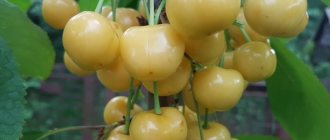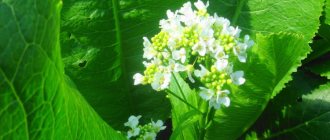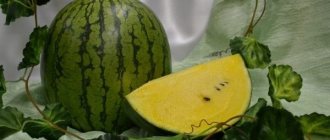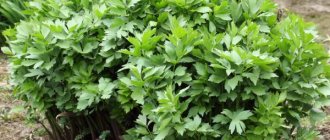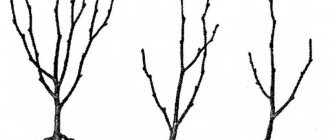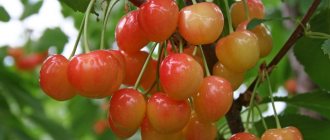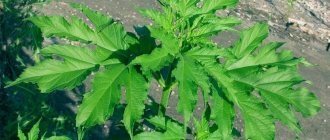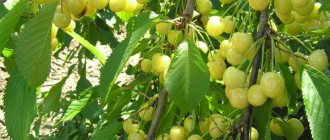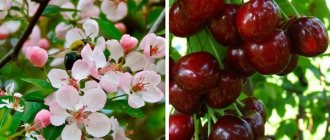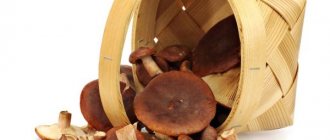Description and features
The first who had a chance to taste these juicy fruits were the Romans. In general, this delicacy has been known since ancient times; it was eaten hundreds of years ago. It was the Italians who helped bring the berry to Europe. Cherry orchards have been blooming there for about a couple of thousand years.
The fruits came to our country much later. They gradually moved from the south of the state to the north. But the trees themselves certainly would not have ended up in Siberia. Here the relocation was facilitated by the experiments of breeders. As a result, such vegetation can be found both in the Far East and in the Moscow region.
It is interesting that in specialized texts cherries are called “bird cherries”. It is also called abroad. If we consider the botanical characteristics, then this is the rose family. As for the genus, it is classified as “plum”.
The trees are quite tall; in the wild they can grow up to 20 meters in height. This plant is a perennial plant, and every year it grows quite noticeably, especially for young specimens.
As a rule, gardeners operate fruit trees for no more than twenty years. But, given a good set of circumstances in nature, a plant can feel good for decades. The age of the most mature specimens reaches seventy.
If you are planning to plant not one tree, but a couple or several, it is important to take into account that their root system is very spreading. With its “underground hands” the plant captures a large horizontal surface. But over time, the roots may well go deeper. Their height in the ground can reach one and a half meters.
Like most other fruit trees, in the first years of life the bark is light, slightly reddish and smooth. With age, the surface of the trunk becomes rougher and may begin to peel off.
If you come across a cherry tree in the photo , then you can easily see that it has a very lush crown. All branches are literally strewn with leaves of a rich emerald hue. They have an oblong regular shape. The edges of cherry leaves are serrated. The veins are very clearly visible. As for the size, on average it is about fifteen centimeters in length.
But before the leaves appear on the tree, flowers bloom. They are small and white. For the ovary to develop, there must be a pollinating plant nearby. Different varieties require certain types of such “catalysts”.
But the greatest value for us is, of course, the fruits. Each of them “sits” on a long stalk. The average size of the berry is a couple of centimeters in diameter. The shape can be round, or maybe slightly elongated. The color depends on the variety. There are pale yellow specimens, and there are also dark brown ones. The pulp of the fruit is incredibly aromatic and sweet. And inside you can find a small round bone.
How to choose a place to plant cherries
The first thing you need to do is determine the place where the tree will be planted. In any case, they will feel more comfortable in an area protected from the north wind; the southern slopes of the hills may be an ideal place. It should be located in the most protected place even if the variety is frost-resistant. Cherries should be planted in an elevated place, even if the elevation has to be created artificially. It should be remembered that good lighting is very important for cherries.
The tree is not indifferent to the fertility of the soil; it should be light, moisture-permeable, preferably medium-loamy, aerated. Planting on heavy clay or peat soils is not advisable. Cherries will not tolerate wetlands, so you should avoid areas where groundwater is close.
Experienced gardeners suggest: in order to get a good harvest, you should plant 2 or 3 cherries of different varieties on your plot. You can also place cherries with the same flowering period as cherries not far from the cherries.
Varieties
There are completely different varieties of cherries . And there are dozens of them. But they are all divided into two large groups:
- Soft. These are not easy to work with. They are very easily injured and deformed.
- Elastic. Suitable for both transportation and processing.
Also, there are three different subgroups based on flowering times: early, middle and late. The first category includes cherries and put . You can get a harvest by the middle of the first summer month. The tree is not tall, reaching a maximum of six meters. The berries are burgundy. Their pulp is juicy, quite dense, and has a slight sourness.
When it comes to how well a plant bears fruit, keep in mind that you can harvest about thirty kilograms of crop per season. In winter, this representative of the flora feels quite comfortable.
But, nevertheless, minor damage due to frost cannot be ruled out. Feels great in the central region. Despite all these advantages, there are also certain problems. For example, high humidity can cause cracks in fruits.
Another excellent early variety is “Ovstuzhenka”. This crop is known for its short growth, about three to four meters. This is important because these sizes make harvesting easier. The berries are slightly smaller than the previous variety. Their color is dark. They are distinguished by their sweet taste and good consistency.
Moreover, the branches will be literally strewn with berries. During the fruitful period, you can harvest as much as fifty kilograms of crop, or even more. But we are talking about mature specimens; young ones will produce half the exhaust.
Tolerates low temperatures well. It is also hardy when it comes to diseases and pests. It takes root not only in the center of Russia, but in the middle zone, as well as in the Chelyabinsk region.
"Dirty." This is another variant of the variety that produces a harvest in early summer. The five-meter tree has small pale fruits that look like yellow cherries . But the pulp is incredibly tender and aromatic. Productivity is not as high as in the previous case.
The maximum you can count on is twenty kilograms per season. Don’t expect all the ovaries to give you ripe fruit at the same time. Their maturation is not synchronous. The first fruits will appear no earlier than three years after planting. Not particularly hardy when it comes to low temperatures.
Among those varieties that bear fruit not so quickly, but only by mid-summer, there are also many interesting representatives. One of these is “Fatezh”. Of course, it does not differ in the size of the fruit. But it differs in performance. Up to fifty kilograms of edible delicacy can be collected from one bush.
Therefore, you must remember to do pruning on time, otherwise the branches will begin to break under the weight of the fruit. The berries themselves are yellowish with a bright red blush. Their taste is excellent. These specimens are not suitable for the north, but they will feel good up to the middle zone.
Not so long ago, gardeners began to offer seedlings of the “gift to Stepanov” variety. Small berries of dark red tones are already loved by gardeners. Their flavor potential is great. Apart from the center of our country, culture is doing well even in some areas close to the north.
The late variety “Bryanskaya pink” is one of the most popular. It has pinkish berries with a yellow interior. The bark tolerates frost without problems. But the ovaries may suffer after spring temperature fluctuations.
"Jealousy." This option has been tested for years. In addition, its harvest is the most attractive in appearance. Pourable berries of a very deep burgundy hue.
If you like black cherries , then turn your attention to the Daibera variety. The productivity of such plants is simply amazing.
The maximum bar is 170 kilograms. But they will not live in harsh climatic conditions. They don't like humidity either. This is fraught with fungus. The “Black Prince” and “Mulatto” have the same dark color. Many people value dark-colored berries for their beneficial composition.
Early varieties
Here we go. The most common early ripening variety. Frost-resistant, early-fruiting, medium-yielding sweet cherry. An adult tree reaches medium size (8-10 meters).
Ripe berries acquire a dark red, almost black color and have an impressive mass (9 grams). The variety is immune to coccomycosis. Ideal for transportation. Suitable pollinators are Tyutchevka, Ovstuzhevka, Bryansk Rozovaya.
Yellow homestead. Cherry is quite resistant to frost and drought. Reaches large sizes. Self-fertile tree with high yield. Ripe yellow fruits have a sweet taste with a slight sourness. Not suitable for transportation.
Raditsa. The earliest ripening representative of the species. Needs pollinators (Bryanskaya rosea, Generalskaya, Iput). The berries have a burgundy color and a rich, sweet taste. The tree is small in size and has a neat crown.
The benefits and harms of cherries
We can talk about the merits of this delicacy for a long time. But in order to understand what exactly the benefits of cherries , it is worth considering its composition. There are also vitamins A, B and many others. And trace elements such as iron, copper, potassium and magnesium. This bouquet of useful substances can increase your body's resistance to various diseases.
If you have problems digesting food, then such a treat can help the gastrointestinal tract. When not everything is in order with the blood vessels, and the pressure is also fluctuating, then such a food supplement will come in very handy.
Special organic substances that are part of the berries can affect the quality of blood. If you have concerns about the formation of plaques and blood clots, then you definitely shouldn’t neglect this treat. As in the case of severe pain. There are many reviews that the product can combat such a problem.
There are many folk recipes for fighting colds, so the juice of these berries can be safely added to this list. But this does not apply to jam. After all, when cooking, high temperatures are used, and they negatively affect beneficial substances, or simply destroy them.
And this sweet treat, unlike various cakes and sweets, does not harm the teeth, but on the contrary, can protect them from caries. You shouldn’t get rid of the stalks either. They will be useful for those who are stressed, but are afraid to take antidepressants. Take a handful and prepare a medicinal compote. Those who have already tried it say that there is an effect.
In addition, this is a real lifesaver when you want to give your child something tasty, but not harmful. B vitamins and carotene will come in handy for a growing body. But this does not apply to children under one year old. It’s better not to give them such goodies.
Light berries have their advantages. For example, a high content of vitamin C. In addition, they are most preferable for people suffering from food allergies. Iodine-containing products are very relevant if you have problems with the thyroid gland. And our seasonal product is included in this list.
Eating cherries threatens you with heartburn, but its “sister” does not have such side effects. Women not only enjoy eating juicy fruits, but also make various cosmetics from them, masks, for example. It makes sense to do such a compress if you suffer from acne.
The heroine of our article has another interesting property. Many pregnant women note that after such a dessert, the feeling of nausea that accompanies almost all women during these nine months goes away.
One handful of dessert before your main meal will help you feel full faster. It will seem to you that hunger is no longer so strong. This means your chances of overeating are reduced. So the fight against excess weight will be easier. There are even many diets based on a diet of berries. But here you have to be very careful.
Such a wonderful product has its drawbacks. For example, those who have stomach problems need to be very careful. Don't get carried away, eat fruits in small quantities. The same applies to those who have problematic intestines. If you are prone to diarrhea, minimize the amount of product in your menu.
Another harm to cherries may be associated with a high content of natural sugars. Diabetics especially need to be careful. It is very difficult to resist and not immediately devour a kilogram of such a treat. But you shouldn't do this.
If you don’t want to get an upset stomach and bloating, don’t overload on the fruits - a maximum of three hundred grams at a time. For the same reason, they should not be used by those who have difficulties with intestinal patency.
The most popular varieties of cherries
As with all stone fruit crops, the winter hardiness of flower buds and the winter hardiness of wood in cherries are inherited separately: a variety can be winter hardy as a whole, but with flower buds that freeze annually, and vice versa. Among the varieties that are winter-hardy in both respects, we note the following: Fatezh (VSTISP, Moscow), Bryanskaya Rozovaya, Veda, Tyutchevka, Iput, Revna.
yellow cherry
In terms of fruit quality, the varieties of the Non-Chernozem Zone are close to the southern ones, the largest-fruited ones produce cherries weighing more than 5 g: Sadko, Lyubimitsa Astakhova, Pamyat Astakhova, Iput, Tyutchevka, Raditsa, Revna.
There are two types of berries according to their consistency:
- Bigarro - with dense, gristly pulp - is more valuable and is stored for a long time;
- gini - with delicate, soft fruits - are less transportable and are more common among early ripening ones.
Cherry fruits are very healthy. They contain from 7 to 18% sugars, fiber, pectin, organic acids, and vitamins. Sweet cherries improve immunity, improve digestion, and dark fruits also have an anti-sclerotic effect.
How to grow from seed
Many people believe that germinating such a plant from scratch is a thankless process. Why? Yes, because you never know which variety will end up decorating the garden. Here you need to be prepared for the fact that the tree will not produce rich, fleshy fruits, but modest sour berries.
In addition, you will have to wait a year before fruiting. But if you are ready for all this and are not afraid of difficulties, then go for it! After all, a cherry from a pit can turn into a very productive tree.
What should you take care of first? Of course, you need to select good seed material. You should not plant one core. Take ten at once. All of them most likely will not germinate. Two or three pieces will be planted idle. The rest should sprout.
No preparations in advance. Material that has been stored since last year is not an option. Take it fresh. Moreover, the berries must be very ripe. And definitely local. So, if you bought a treat in a store and suddenly decided that it was suitable material for sowing, then this is a mistake. After all, it was most likely brought from another region. Or even countries. This means that it will not be suitable for your climatic conditions. So look for local berries.
And then everything will depend on your place of stay. If you do not live in the south, but closer to the middle zone, you should not try your luck and immediately try to send the sprouts into the street soil. As a rule, we eat the delicacy in the middle of summer, which means we prepare the seeds at the same time.
By the time the seeds germinate, autumn is already on the doorstep, and not every seedling can withstand such climatic conditions. Therefore, he will have to overwinter in sand, or vermiculite. And don't forget to moisturize them, but don't overdo it. Room temperature is not suitable for such preparations; cooler air is needed.
Optimal conditions are just above zero degrees. So a basement can be a great solution. After all the preparatory work is done, you can forget about the bones for six months. You will only need to remember them occasionally, for ventilation. And in the spring hardening will begin. Those. You will need to take the seeds outside or onto the balcony for a short time.
If you intend to plant in the Rostov region or Stavropol region, then are sent to open ground for the winter But before that, it needs several months, just as in the previous case, to be stored in a humid environment. Approximately the same scheme applies to the southernmost regions of our country. You can safely plant the preparations by autumn. And in the spring you will already receive shoots.
There is one general piece of advice, regardless of what climate zone you live in: before hardening the seeds, you should apply a fungicide to them. Then the likelihood that you will become infected with various diseases decreases significantly.
How to determine that it is possible to move the workpiece into a pot or plant it in the garden? There is one exact sign - when the “flaps” of the seed have separated, and a small sprout peeks out.
You need to plant it in a small half-liter container. Not empty, of course. Fill it as standard - drainage with a layer of about 4 centimeters, and soil on top (garden stores sell special soil for fruit trees, it’s better to take it). Dry soil is not suitable, pour some water into it first.
Bury the sprouted seeds a centimeter. Sprinkle on top. Of course, it’s good if there is a separate pot for each specimen. But if not, it's okay, just make sure that the distance between them is at least ten centimeters.
These containers should be located where the sun does not bake and it is not too hot. When the cores become cramped in their “home”, they will have to move to a larger “dwelling”. This procedure will need to be constantly repeated as the seedlings grow.
Of course, if you are not in a hurry, it is quite possible to wait five years until the first fruits appear. But, if you want to taste them faster, then when the representative of the flora turns two years old, it’s time to vaccinate it. So you will need another, already mature tree. After this procedure, when it is clear that it was successful, you can prepare the plant for moving to open ground.
Also, in the second year of life, it’s time to think about pruning in order to form a crown. And don’t forget, from the age of one year there is a need for fertilizers. And finally, choosing a location. In order for a cherry tree to appear, the tree must be located in a part of the garden where there are no strong winds. Ideally, if we sat down, it would be on the south side.
Water should be delivered to the roots of the plant every couple of weeks. In this case, watering should be very abundant. One plant needs fifty liters of water. For cold weather, it is better to build a special frame for the tree, or at least cover it with special material.
Features of cherries
Stone fruits are grown for their fruits. They are tasty, healthy, low-calorie, suitable for preparation, and ripen early. Cultivated cherry is a fast growing woody plant. In warm climates, trees live up to 100 years and grow up to 12-15 m in height.
The type of root system is horizontal. There is only one tap root, it is formed at 1-2 years of life, and later branches. Cherries have a straight, tall trunk, covered with light bark, oval or blunt heart-shaped fruits (true drupes) covered with red, red-orange or light yellow skin.
Reference! If a cherry variety for the Middle Zone is self-fertile or partially self-fertile, then for stable fruiting, 2-3 trees of a different variety are planted next to it.
For decades, domestic breeders have been breeding low-growing varieties. The dominant gene for tallness is suppressed using low- and medium-sized domestic rootstocks for propagation:
- VSL-1, VSL-2 – low-growing;
- LTs-52, L-2, VTs-13 – medium height.
Dwarf cherry varieties attract summer residents and farmers with their ease of care, productivity, and quick adaptation to frequently changing weather conditions. Compact trees do not need a large area to grow.
VSL-2 is considered the best low-growing (dwarf) rootstock. The height of the tree does not exceed 2.5-3 m. There are no basal shoots. The root system is resistant to low temperatures, fruiting begins early. Summer residents solve the problem of growth using their own methods. Cherry cuttings are grafted onto winter-hardy bush cherries.
Why do the leaves curl and turn yellow and what to do?
When the leaves begin to bend into tubes, things are bad. It may be a fungal disease known as scab. This nasty thing can live quietly in dry leaves, and it does not disdain dry fruits. Therefore, prevention is very important here. This is a mandatory cleanup of fallen material. Mulch also has an important function. Periodic treatment with chemicals also makes sense.
From the same list is the disease coccomycosis. Little of. Although the greens do not suffer, the fruits also become inedible. And in the end, you can say goodbye to the tree altogether. This disease can be distinguished by reddish spots. Gradually they capture all the foliage, which as a result falls off.
This attack can appear due to too much watering, or when there is high humidity around the plant. If you cannot avoid such problems, arm yourself with Bordeaux mixture and vitriol. Please note that the processing should not be one-time; a course of procedures will be required.
Foliage can change its color due to a disease such as chlorosis. Frost can be harmful here. The drugs described above will help. You also need to get rid of the affected areas.
Late ripening varieties
Tyutchevka. High-yielding cherries that can withstand frost. A mature tree of medium size, with a well-developed crown. The large berries are sweet in taste and have a predominant dark red color. The pollinating varieties Iput and Revna.
Bryansk Pink. The variety is very late in ripening. Resistant to coccomycosis and fungal diseases. The height of an adult tree is 10-12 meters. The fruits are pink, juicy and very sweet. Needs pollinators (Tyutchevka, Revna, Iput, Ovstuzhevka).
What work needs to be done in the fall to prepare fruit trees for winter
Planting and replanting trees in autumn: recommendations from experienced gardeners
What are the benefits of pomegranate for health and immunity?
Why are there few berries and they are rotting? What should I do?
Excess moisture can lead to cracks in the fruit. It happens that the summer turned out to be very rainy, or maybe the gardener himself overdid it with watering. Then the berries burst. To help the tree cope with this problem, feed it with potassium and phosphorus supplements. The same thing can happen if, on the contrary, there is little moisture.
A lot depends on the name of the variety. Those who are not afraid of cold weather are afraid of drought. The result is rot. True, pests can also cause rotten growths. The most active among them is the cherry fly. This will require a powerful attack by the Regent, and not just one time. Use this protection before flowering begins.
Planting and growing
The soil for cherries should be drained and light (sandy or medium loamy), and also have a pH close to 6.
To plant seedlings, you need to dig a hole 70 x 70 cm with a depth of 60 cm. In this case, discard the upper fertile layer in one direction, and the lower clayey layer in the other. Place a wooden stake right in the center of the hole and fill it 2/3 with the top fertile layer mixed with mineral and organic fertilizers (20 kg of compost or rotted manure + 1 kg of superphosphate + 100 g of potassium chloride + 1 kg of ash). At least 2 people must participate in planting cherry seedlings at the same time. The first one should carefully install the seedling from the central stake on the north side and spread the roots evenly. The second gradually covers them with fertile soil. To prevent empty spaces from forming between the soil and the roots, you need to shake it slightly while burying the seedling. The root collar should be about 5 cm above ground level. After planting, make a hole in the ground around the seedling and pour 2 buckets of water into it. As soon as the water is completely absorbed into the soil, the hole must be thoroughly mulched with a layer of humus or peat. Tie the seedling to the previously dug stake using twine or use a piece of film for this. The optimal planting pattern is 4×5 m.
Sweet cherries are cross-pollinated plants, so for fruiting, plant several seedlings nearby, preferably of different varieties. The best fruit set of other cherry varieties growing nearby is ensured by the Crimean variety. At the same time, he himself has small fruits.
In the first year after planting, you should refuse to apply fertilizers. In the next 3 years, each tree is fertilized in the spring with 20 g of urea diluted in water. As soon as an adult cherry tree begins to bear fruit, in addition to urea, 10 kg of compost or mullein and 200 g of ash should be added to the soil. 60 g of superphosphate and 20 g of potassium chloride. For 7-8 years after planting, the amount of organic fertilizers applied should be increased, and the amount of mineral fertilizers should be left at the same level. It should be noted that urea must be applied in the spring, and potash and phosphorus fertilizers in the fall, simultaneously digging up the soil under the trees to a depth of 20 cm (without damaging the roots!).
Once every 5-6 years, the soil around the cherries needs to be limed, adding from 400 to 800 g per 1 m2 of slaked lime (on light soils the norm is less, on heavy soils - more). Lime should be applied in the fall, along with other mineral fertilizers. First, it is evenly scattered over the surface, after which it is dug up.
Watering sweet cherries is similar to that of cherries: during the period of fruit ripening it needs to be increased, and as autumn approaches, on the contrary, it should be gradually reduced.
Why is resin released?
Such discharge from the trunk is called gommosis. If your home cherry tree begins to spew gum, it means it may soon die. The attack of frosty air could be the reason for this. Or maybe there was careless handling of tools while cleaning the bark. Too much yield or incorrect pruning can also affect the appearance of discharge.
Your actions in case of such a lesion: first arm yourself with a knife, and use it to remove the affected area, deepening the tool into the trunk a few centimeters. The next stage is sterilization. To help - ash solution, or vitriol solution. Afterwards, be sure to cover the wound with something. A classic of the genre - garden var.
Cherry taste
I have many acquaintances who are cherry fans. How do you feel about them?
When it comes to describing taste, I try to convey my emotions every time. The gifts of nature in their original form simply cannot help but evoke them. Or am I such a sensitive young lady?

